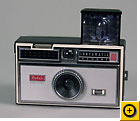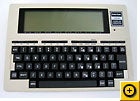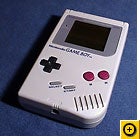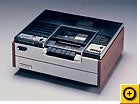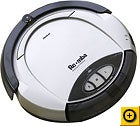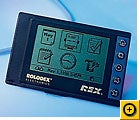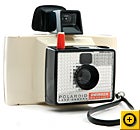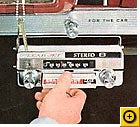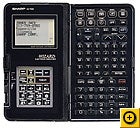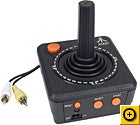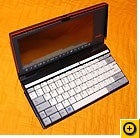The Ugliest Products in Tech History
All of this gear may have worked just fine, but it sure looked bad doing it. Here are 10 examples of the worst product designs in the tech industry's storied past.
By Emru Townsend , PCWorld Oct 8, 2007 11:00 am
Acoustic Coupler Modems

The 1970s aren't exactly known for great design (shag rugs, The Osmonds' hairstyles), but one egregiously tacky piece of tech from that era was also one of the most vital for the pioneers of our modern, always-connected world: the acoustic-coupler modem. Back when Ma Bell ruled the telephony landscape and phones were hard-wired into walls, the only way to connect your computer to the outside world was to make the call manually, listen for the carrier tone, and then push the handset into the twin suction cups mounted on top of the modem. A triumph of function over form, these devices were how the first generation of Netizens got their online fix. Too bad it looked like you were sticking your phone into two miniature plungers. -- Emru Townsend
Osborne 1

The idea of portable computers is so commonplace now that we don't even call them portables. Terms like laptop and notebook convey the current state of the art: full-featured computers that you can easily tuck under your arm or into a knapsack. But in 1981 the first truly portable computer, the Osborne 1, weighed in at a bulky 24 pounds. The box included a 5-inch monochrome monitor, a full-size keyboard, and two floppy disk drives. The first generation of computer road warriors cut their teeth (and built up their biceps) carrying the popular but awkward Osborne, but as personal computers began getting smaller and sleeker, the suitcase-sized (and -shaped) Osborne 1 began looking like an unfortunate throwback.
Motorola DynaTAC 8000X

There are some things that are so sleek and gorgeously crafted you wonder how they could have come from such, er, less-than-glamorous forebears. Exhibit A is Liv Tyler. Exhibit B is the Motorola Razr, whose ancestor is the DynaTAC 8000X--the very first cell phone. At an unwieldy 10 inches tall (not including the antenna), the blocky 28-ounce 8000X wasn't all that visually or ergonomically appealing even in the big-hair, skinny-leather-tie 1980s. However, people were so awed by the concept of a truly mobile phone when the 8000X made its 1983 debut that thousands of people happily dropped $3995 for the sake of being cutting-edge. By 1984 there were over a quarter of a million wireless subscribers worldwide.
Microsoft Windows 1.0

The first Macintosh operating system popularized the concept of graphical user interfaces when it was launched in 1984, and a year later Microsoft responded with the first version of Windows--and no GUI has been as blocky or garish since. To be fair, the first Windows wasn't so much an operating system as an add-on to MS-DOS, which meant living with design groaners like ALL-CAPITAL file names and the still-very-DOS-like graphics standard. Though more than a few people would contend that Microsoft has been playing catch-up with Apple's design sense ever since, the ugly duckling did eventually turn into a swan with Windows Vista. And, as we understand it, Windows has done kind of okay in the marketplace.
Nintendo Virtual Boy

In 1995, Nintendo capitalized on the virtual-reality craze by coming out with the Virtual Boy game console. The "portable" unit consisted of goggles mounted on a stand (looking like some kind of compact, plastic peep show), along with a full-size controller. By rapidly displaying slightly different images to the right and the left eye, the goggles made players experience the illusion of three dimensions. Although the technique is not unlike the one used for 3D IMAX movies, the console's cheaper technology meant that instead of bright colors, players got pixilated red-on-black monochrome images. The Virtual Boy still has its fans (check outwww.virtual-boy.org), but back in the mid-1990s people stayed away in droves. Nintendo pulled the plug on the Virtual Boy the year after its debut.
Tiger Electronics Furby

It sounds like the ultimate geek fantasy: Give your child an intelligent robot for Christmas--even if it does look like a cross between Gizmo from the Gremlins movie, a Muppet, and a Warner Bros. cartoon character. Thanks to its CPU, sensors, and moving parts, the original Furby could react to light, sound and touch: waking up in the morning, responding to words and sounds, and responding to having its fur stroked. Out of the box, Furbys spoke "Furbish," but could be taught to repeat certain English words if they were given positive reinforcement at the same time. In 1998 they caused enough of a sensation that the $35 toys quickly sold out in toy stores, driving prices up into the hundreds and riling up parents who clearly hadn't learned from the Tickle Me Elmo fad two years earlier.
iMac Flower Power and Dalmatian

Apple's first iMacs were like a breath of fresh air to the computer-buying public. The bright, playful colors and rounded design of the all-in-one computers were in sharp contrast to PCs, which were still mostly beige blocks. Among the 2001 lineup of iMacs were two new color schemes, Flower Power and Dalmatian (white with hazy blue spots). No doubt Steve Jobs felt that the softly colored hues would be considered soothing and tasteful, but frankly they were a bit more reminiscent of a cheap shower curtain. Even the Mac faithful agreed, and saved their oohs and aahs for the Indigo and Graphite models released at the same time.
Neuros II Digital Audio Computer

In 2004, Neuros Audio released the Neuros II, the second version of what was already the mother of all audio players: It played MP3, Ogg Vorbis, WMA, and uncompressed WAV files. It could also record MP3s through a line input, a built-in microphone, or an FM tuner. Perhaps most innovative was the player's two-part design: The player unit was mounted inside an upgradable "backpack" that contained the battery and the storage media (from a 128MB flash drive to an 80GB hard drive). The downside was that the whole thing looked something like a black brick, at the ungainly size of 5.3 by 3.1 by 1.3 inches--at a time when audio players were getting sleeker and more strikingly designed. However, the legion of enthusiasts and tinkerers that Neuros catered to were more interested in specs than looks, and they happily snapped the player up.
Commodore 1541 Floppy Disk Drive

The Commodore 64 is arguably one of the best-designed computers ever. It's boxy enough to remind you it's from the 1980s, but it's got enough curves in just the right places that its look is almost timeless. Unfortunately, the external Commodore 1541 disk drive coming with it was pretty much a slab of plastic that was bulkier and heavier than the computer it was supporting. It was noisier too, making gronk sounds during ordinary operation and clacking when it encountered read or write errors. The drive also ran hot, which led to many drives being adorned with fans on the rear vents. The only thing less appealing than one of these monsters on your desk? Two of them.
Microsoft Zune Player

When Microsoft launched its "iPod killer" in 2006, the company made sure to include many of the things that made Apple's iconic players a runaway success, including great sound and an integrated music store/manager. Somewhere along the way, though, Microsoft forgot to include the iPod's sexy design, opting instead for a boxy plastic casing and a spectacularly unflattering brown color. The Redmond giant has released Zunes in other, "limited edition" colors, and did manage to achieve its somewhat modest goal of selling a million Zunes in seven months. Still, it's a bad sign when someone comes up with a Web site built entirely around the joke that no one would steal an iPod if it were hidden in a Zune casing--and people actually want to buy that casing.
By Emru Townsend , PCWorld Oct 8, 2007 11:00 am
Acoustic Coupler Modems

The 1970s aren't exactly known for great design (shag rugs, The Osmonds' hairstyles), but one egregiously tacky piece of tech from that era was also one of the most vital for the pioneers of our modern, always-connected world: the acoustic-coupler modem. Back when Ma Bell ruled the telephony landscape and phones were hard-wired into walls, the only way to connect your computer to the outside world was to make the call manually, listen for the carrier tone, and then push the handset into the twin suction cups mounted on top of the modem. A triumph of function over form, these devices were how the first generation of Netizens got their online fix. Too bad it looked like you were sticking your phone into two miniature plungers. -- Emru Townsend
Osborne 1

The idea of portable computers is so commonplace now that we don't even call them portables. Terms like laptop and notebook convey the current state of the art: full-featured computers that you can easily tuck under your arm or into a knapsack. But in 1981 the first truly portable computer, the Osborne 1, weighed in at a bulky 24 pounds. The box included a 5-inch monochrome monitor, a full-size keyboard, and two floppy disk drives. The first generation of computer road warriors cut their teeth (and built up their biceps) carrying the popular but awkward Osborne, but as personal computers began getting smaller and sleeker, the suitcase-sized (and -shaped) Osborne 1 began looking like an unfortunate throwback.
Motorola DynaTAC 8000X

There are some things that are so sleek and gorgeously crafted you wonder how they could have come from such, er, less-than-glamorous forebears. Exhibit A is Liv Tyler. Exhibit B is the Motorola Razr, whose ancestor is the DynaTAC 8000X--the very first cell phone. At an unwieldy 10 inches tall (not including the antenna), the blocky 28-ounce 8000X wasn't all that visually or ergonomically appealing even in the big-hair, skinny-leather-tie 1980s. However, people were so awed by the concept of a truly mobile phone when the 8000X made its 1983 debut that thousands of people happily dropped $3995 for the sake of being cutting-edge. By 1984 there were over a quarter of a million wireless subscribers worldwide.
Microsoft Windows 1.0

The first Macintosh operating system popularized the concept of graphical user interfaces when it was launched in 1984, and a year later Microsoft responded with the first version of Windows--and no GUI has been as blocky or garish since. To be fair, the first Windows wasn't so much an operating system as an add-on to MS-DOS, which meant living with design groaners like ALL-CAPITAL file names and the still-very-DOS-like graphics standard. Though more than a few people would contend that Microsoft has been playing catch-up with Apple's design sense ever since, the ugly duckling did eventually turn into a swan with Windows Vista. And, as we understand it, Windows has done kind of okay in the marketplace.
Nintendo Virtual Boy

In 1995, Nintendo capitalized on the virtual-reality craze by coming out with the Virtual Boy game console. The "portable" unit consisted of goggles mounted on a stand (looking like some kind of compact, plastic peep show), along with a full-size controller. By rapidly displaying slightly different images to the right and the left eye, the goggles made players experience the illusion of three dimensions. Although the technique is not unlike the one used for 3D IMAX movies, the console's cheaper technology meant that instead of bright colors, players got pixilated red-on-black monochrome images. The Virtual Boy still has its fans (check outwww.virtual-boy.org), but back in the mid-1990s people stayed away in droves. Nintendo pulled the plug on the Virtual Boy the year after its debut.
Tiger Electronics Furby

It sounds like the ultimate geek fantasy: Give your child an intelligent robot for Christmas--even if it does look like a cross between Gizmo from the Gremlins movie, a Muppet, and a Warner Bros. cartoon character. Thanks to its CPU, sensors, and moving parts, the original Furby could react to light, sound and touch: waking up in the morning, responding to words and sounds, and responding to having its fur stroked. Out of the box, Furbys spoke "Furbish," but could be taught to repeat certain English words if they were given positive reinforcement at the same time. In 1998 they caused enough of a sensation that the $35 toys quickly sold out in toy stores, driving prices up into the hundreds and riling up parents who clearly hadn't learned from the Tickle Me Elmo fad two years earlier.
iMac Flower Power and Dalmatian

Apple's first iMacs were like a breath of fresh air to the computer-buying public. The bright, playful colors and rounded design of the all-in-one computers were in sharp contrast to PCs, which were still mostly beige blocks. Among the 2001 lineup of iMacs were two new color schemes, Flower Power and Dalmatian (white with hazy blue spots). No doubt Steve Jobs felt that the softly colored hues would be considered soothing and tasteful, but frankly they were a bit more reminiscent of a cheap shower curtain. Even the Mac faithful agreed, and saved their oohs and aahs for the Indigo and Graphite models released at the same time.
Neuros II Digital Audio Computer

In 2004, Neuros Audio released the Neuros II, the second version of what was already the mother of all audio players: It played MP3, Ogg Vorbis, WMA, and uncompressed WAV files. It could also record MP3s through a line input, a built-in microphone, or an FM tuner. Perhaps most innovative was the player's two-part design: The player unit was mounted inside an upgradable "backpack" that contained the battery and the storage media (from a 128MB flash drive to an 80GB hard drive). The downside was that the whole thing looked something like a black brick, at the ungainly size of 5.3 by 3.1 by 1.3 inches--at a time when audio players were getting sleeker and more strikingly designed. However, the legion of enthusiasts and tinkerers that Neuros catered to were more interested in specs than looks, and they happily snapped the player up.
Commodore 1541 Floppy Disk Drive

The Commodore 64 is arguably one of the best-designed computers ever. It's boxy enough to remind you it's from the 1980s, but it's got enough curves in just the right places that its look is almost timeless. Unfortunately, the external Commodore 1541 disk drive coming with it was pretty much a slab of plastic that was bulkier and heavier than the computer it was supporting. It was noisier too, making gronk sounds during ordinary operation and clacking when it encountered read or write errors. The drive also ran hot, which led to many drives being adorned with fans on the rear vents. The only thing less appealing than one of these monsters on your desk? Two of them.
Microsoft Zune Player

When Microsoft launched its "iPod killer" in 2006, the company made sure to include many of the things that made Apple's iconic players a runaway success, including great sound and an integrated music store/manager. Somewhere along the way, though, Microsoft forgot to include the iPod's sexy design, opting instead for a boxy plastic casing and a spectacularly unflattering brown color. The Redmond giant has released Zunes in other, "limited edition" colors, and did manage to achieve its somewhat modest goal of selling a million Zunes in seven months. Still, it's a bad sign when someone comes up with a Web site built entirely around the joke that no one would steal an iPod if it were hidden in a Zune casing--and people actually want to buy that casing.







 How do we loathe AOL? Let us count the ways. Since
How do we loathe AOL? Let us count the ways. Since 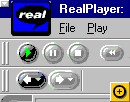
 This might be the worst version of Windows ever released--or, at least, since the dark days of Windows 2.0.
This might be the worst version of Windows ever released--or, at least, since the dark days of Windows 2.0. 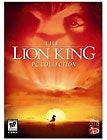 Few products get accused of
Few products get accused of  No list of the worst of the worst would be complete without Windows' idiot cousin, Bob. Designed as a "social" interface for Windows 3.1, Bob featured a
No list of the worst of the worst would be complete without Windows' idiot cousin, Bob. Designed as a "social" interface for Windows 3.1, Bob featured a 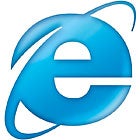

 The name-your-price model worked for airline tickets, rental cars, and hotels--why not groceries and gas? Unfortunately, even Priceline spokescaptain William Shatner couldn't
The name-your-price model worked for airline tickets, rental cars, and hotels--why not groceries and gas? Unfortunately, even Priceline spokescaptain William Shatner couldn't 
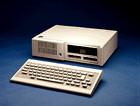 Talk about your bastard offspring. IBM's attempt to build an inexpensive computer for homes and schools was an orphan almost from the start. The infamous "Chiclet" keyboard on
Talk about your bastard offspring. IBM's attempt to build an inexpensive computer for homes and schools was an orphan almost from the start. The infamous "Chiclet" keyboard on 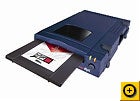

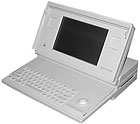 Some buildings are portable, if you have access to a Freightliner. Stonehenge is a portable sun dial, if you have enough people on hand to get things rolling. And in 1989, Apple offered a "portable" Macintosh--a 4-inch-thick, 16-pound
Some buildings are portable, if you have access to a Freightliner. Stonehenge is a portable sun dial, if you have enough people on hand to get things rolling. And in 1989, Apple offered a "portable" Macintosh--a 4-inch-thick, 16-pound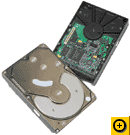
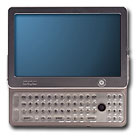 The 14-ounce
The 14-ounce  Appearing at the tail end of the dot com craze, the
Appearing at the tail end of the dot com craze, the  Some things just aren't meant to be done while walking or driving, and one of them is watching DVDs. Unfortunately, that message was lost on Eyetop.net, makers of the
Some things just aren't meant to be done while walking or driving, and one of them is watching DVDs. Unfortunately, that message was lost on Eyetop.net, makers of the 
 Few products literally stink, but this one did--or at least it would have, had it progressed beyond the prototype stage.
Few products literally stink, but this one did--or at least it would have, had it progressed beyond the prototype stage.

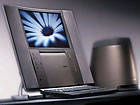

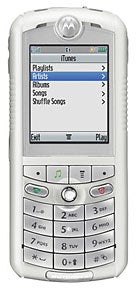
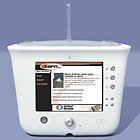

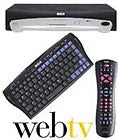
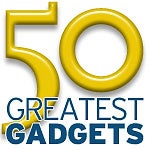 We're living in the golden age of the gadget. Don't believe it? Check your pockets. Odds are you're carrying a portable music player, an electronic organizer, a keychain-size storage device, a digital camera, or a cell phone that combines some or all of these functions. And you'd probably be hard-pressed to live without them.
We're living in the golden age of the gadget. Don't believe it? Check your pockets. Odds are you're carrying a portable music player, an electronic organizer, a keychain-size storage device, a digital camera, or a cell phone that combines some or all of these functions. And you'd probably be hard-pressed to live without them.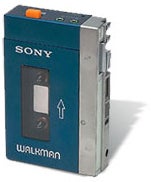






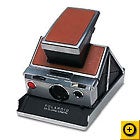


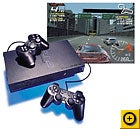
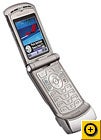

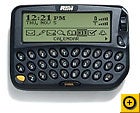
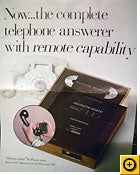
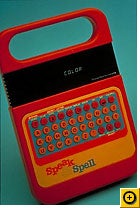

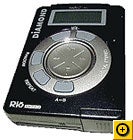


 The first widely used TV remote control had four buttons (power, volume, channel up, channel down) but no batteries; press a button, and a tiny hammer inside the remote would strike an aluminum rod, transmitting an ultrahigh-frequency tone to control the set. The Space Command ruled the living room for more than 25 years before being replaced by remotes using infrared technology. And thus a nation of couch potatoes was born. For more information, see Zenith's
The first widely used TV remote control had four buttons (power, volume, channel up, channel down) but no batteries; press a button, and a tiny hammer inside the remote would strike an aluminum rod, transmitting an ultrahigh-frequency tone to control the set. The Space Command ruled the living room for more than 25 years before being replaced by remotes using infrared technology. And thus a nation of couch potatoes was born. For more information, see Zenith's 
